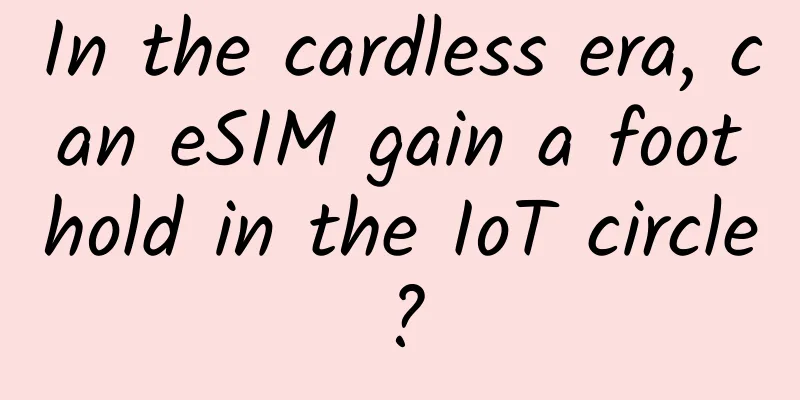In the cardless era, can eSIM gain a foothold in the IoT circle?

|
The basic functions of mobile phones remain unchanged, and SIM cards have not undergone revolutionary changes, but the times are driving changes in SIM cards. This article explores the opportunities and challenges of the Internet of Things with the introduction of eSIM and embedded universal integrated circuit cards (eUICC).
What is an eSIM? To understand eSIM, we need to start with the SIM card. On July 1, 1991, the then Finnish Prime Minister Harri Holkeri used his mobile phone to call the deputy mayor of Tampere. This was the world's first mobile phone call, and the success of this call was largely due to the world's first commercial version of the "Subscriber Identity Module", which is what we usually call the SIM card. The two pieces of data stored in the SIM card correspond to its two important functions:
As an important part of realizing the basic functions of mobile phones, the functions of SIM cards have not changed since their birth, and only the size has changed. The first generation SIM (1FF) is similar to a credit card in appearance and size, but mobile phones are constantly getting smaller, so the simple and compact mini-SIM (2FF) was launched. The updated form factor limits the chip and contact arrangement to a very small card, which is also convenient to pull out from the phone. Later, micro-SIM (3FF) and nano-SIM (4FF) were launched one after another, but the shape, contact arrangement and characteristics of the embedded chip are still not much different from 26 years ago. eSIM development encounters obstacles The basic functions of mobile phones remain unchanged, and there is no revolutionary change in SIM cards, but the times are driving changes in SIM cards. As mobile phones become thinner and lighter, the space inside the phone is becoming more and more crowded. In order to ensure communication functions, mobile phone manufacturers have to leave a SIM card slot, so Apple and Samsung are working hard to promote the use of eSIM cards in mobile phones. The eSIM card is an embedded SIM card, which embeds the traditional SIM card directly into the device chip instead of adding it to the device as an independent removable component. The simplest and most intuitive benefit of this is saving space inside the phone. Not only that, since there is no need to insert a physical SIM card, it also becomes easier for users to switch operators and plans. For mobile phone manufacturers such as Apple and Samsung, they are obviously willing to promote eSIM. This kind of solution allows them to fully control all the hardware inside the mobile phone. From now on, the mobile phone does not need to have a SIM card slot, and the waterproof design will become simpler. This is obviously bad news for SIM card manufacturers and operators, because it will be easier for consumers to change operators. When going abroad, users can log in to the local mobile network directly through their mobile phones, without having to go to the store to buy a physical SIM card like now.
Of course, there are no technical difficulties in the application of eSIM cards in mobile phones, so the popularization of eSIM has become a game for all parties. Obviously, mobile network operators want to maintain the current user stickiness. They do not want to give the right to choose operators completely to mobile phone manufacturers such as Apple and Samsung. Therefore, they insist on using physical SIM cards, which is also the biggest obstacle to the popularization of eSIM. An industry expert said: "In an interdependent system, no one can change unless everyone changes at the same time." However, we can still see that in the past two years, the number of terminals of mobile phone models under OPPO, vivo, Samsung China, Xiaomi, Lenovo, ZTE, Meizu, LeTV, and Smartisan that have achieved international roaming services through the eSIM technology provided by domestic manufacturers has exceeded 100 million, which shows the advantages of this technology and the market demand. IoT helps eSIM development Since the application of eSIM on mobile phones faces huge obstacles from operators, can eSIM still play a role? Robin Duke-Woolley, CEO of Beecham Research, a research organization dedicated to assisting the development of the Internet of Things, said the answer is yes.
For example, Apple Watch Series 3 is a good example. As a wearable device, smart watches are much smaller than mobile phones in both size and weight. If you want to get a good user experience, it is obviously unrealistic to insert a physical SIM card. eSIM is a good solution. Moreover, for operators, whether it is bundling multiple terminals with a mobile phone or using a single number for a smart watch, wearable devices or other IoT devices will undoubtedly bring new users to operators without affecting the number of original users. In the context of sluggish growth in smartphone shipments, operators should also be happy to see new applications attract new customers. Facing the Internet of Things market, eSIM cards have broad market prospects in the future, including Internet of Vehicles, wearable devices, smart homes, smart homes, remote smart meter reading, wireless mobile POS, location tracking, etc. The value of eSIM For product manufacturers (OEMs), the need to connect products to the Internet is urgent. As shown in the figure below, unconnected products cannot generate data for new services or be updated with new software features, and will quickly lose their competitive position in the market compared to other connected devices that can perform such operations. In addition, unconnected products cannot achieve remote maintenance and feedback on field performance. The total value of an unconnected product lies in the product itself, while the total value of a connected product includes the product and all services created by its connection. Connected products create more value than unconnected products Essentially, this means that unconnected products may be less likely to gain an advantage over similar competing products in the longer term. OEMs in all industries, such as construction, consumer, energy, healthcare, industrial, networking, retail, security and transportation, must develop service strategies for their products in order to gain an advantage in their future market competition. This means that they must provide Internet connectivity for their IoT products. As this fact becomes more widely understood, the means of connecting IoT products is becoming increasingly important. For mobile operators, the traditional SIM card is both a boon and a problem. It is a boon because it provides increasingly important security guarantees. It is a problem because the number of IoT device connections is growing faster and faster, and the backend work of operating so many SIM cards and matching them correctly to devices is becoming increasingly difficult and costly. Due to the inherent characteristics of SIM cards, the management of a large number of cards, the potential huge costs, and the change of operators have led to the evolution of multiple International Mobile Subscriber Identity (IMSI) and eUICC forms of SIM. Do we need Multi-IMSI and eUICC? The difference between Multi-IMSI and eUICC is very subtle. The eUICC itself is a SIM card that is capable of remote provisioning and comes in multiple form factors. The eSIM refers to the entire solution that provides remote provisioning of the SIM, including the hardware, software, and subscription management system required to deploy the SIM. In addition, the technology for remote provisioning of SIMs has been commercialized for many years, but initially mainly in proprietary solutions. In response to the growing trend of this technology, GSMA, which represents the common interests and interests of mobile operators around the world, created and continues to develop the eSIM specification for remote SIM configuration, which represents the industry's best way to create standards. Remote SIM configuration involves downloading network profiles and network keys, which in turn requires the consent of the network operator that owns the network profile. To perform a network swap, network profiles from two different operators need to be present in the SIM - the original network profile and the network profile to be swapped to. This development is being brought to market by players in all fields, including new entrants and some long-time advocates. In the latter camp is KORE, now a global IoT solution provider, which has long provided connectivity for M2M and IoT solutions. KORE is particularly committed to the transition from Multi-IMSI to eUICC and the eSIM version promoted by GSMA. At this point, Robin said that proprietary networks are a retrograde step and real market development comes from standard specifications as quickly as possible - even if this takes longer. KORE has long worked closely with network operators and GSMA and provides multi-IMSI, and is one of the pioneers in introducing it to the IoT market. Therefore, their views on this transition are instructive and reflect their long experience in this market. For KORE, proprietary eSIM solutions did not provide a significant enough advancement compared to Multi-IMSI, so the still evolving GSMA specification eSIM was their best approach. Furthermore, they believe that both Multi-IMSI and eSIM are relevant for the future, and they intend to continue to offer both to meet different customer needs. Another key issue for all these solutions is the acceptance of mobile operators. Both network switching (eSIM) and IMSI switching (Multi-IMSI) can only be implemented with the consent of the network operators involved in the network profile IMSI. As often described, eSIM is attracting opposition from mobile operators, who are doing everything they can to slow down its development.
But is this correct? Clearly, the eSIM offers a more streamlined and cost-effective way to securely provision mobile connections. It facilitates large-scale deployments in a way that traditional SIM cards will never be able to emulate. So, it is safe to assume that the introduction of the eSIM will significantly increase the number of connected devices on mobile networks at a faster rate than in the past. Of course, the huge potential upside of this freedom to switch also comes with greater risk. A large number of owners of connected devices are given the opportunity to switch mobile operators when their contracts are renewed. In other words, as long as eSIM technology and the willingness of commercial enterprises to share network profiles work as expected, owners are no longer effectively locked into their original choice of operator. Switching operators will have a greater chance of making the right switch, which in turn leads to operators focusing more on issues other than connectivity costs, such as coverage and technical support. This allows real market development to take place. What operators are really concerned about is the increased risk without the reward of higher volumes. So, which comes first, taking on greater risk or getting higher volumes? Operators are trying to determine the latter before accepting the former. Essentially, this suggests that the eSIM market will initially open up with a series of large transactions rather than a large number of small transactions. In this case, the continued need for Multi-IMSI is obvious. |
<<: How 10 popular SD-WAN startups survive in the cracks
Recommend
Programmers learn network hubs and switches
From the perspective of network implementation, n...
Xiao Yaqing from the Ministry of Industry and Information Technology: 6G is currently in the exploratory stage
In November 2019, my country established the Nati...
PoE Basics: Do You Really Understand PoE?
By transmitting both data and power over the same...
5G New Year's Guide
The lack of New Year's atmosphere during the ...
Mid-year review: 10 hottest web startups in 2021
Rising Star If the IT industry has learned anythi...
Three-minute review! A quick overview of 5G industry development trends in December 2021
After the rapid development in 2020, 2021 is a cr...
V5.NET: Hong Kong CN2 server limited 30% off, dual-channel E5 monthly payment starts from 625 yuan
V5.NET is offering a limited promotion for the HK...
Under the 5G trend | A comparison of deployment between China and the United States
At present, 5G communication technology has cause...
China has more than 150 million 5G users, of which 50 million do not use 5G phones
China Mobile and China Telecom announced that the...
DiyVM: Hong Kong dedicated server from 499 yuan, Hong Kong/US VPS 50% off 2G memory package monthly payment from 69 yuan
DiyVM is a Chinese hosting company founded in 200...
Five driving forces and four challenges for 5G development
At the end of June, MWC19 Shanghai was once again...
The dilemma of contemporary 5G users: From being 5G to returning to 4G, we should slow down
If the elderly are the ones abandoned by the Inte...
Controlling the throat of the Internet of Things, what value can wireless communication technology bring to the application field?
Communication technology has been the most talked...
What is the difference between a cell and a sector? What about carrier frequency and carrier wave?
Cell, sector, carrier and carrier frequency are a...
Major upgrade! AsiaInfo Security releases the high-performance AE 40G antivirus software, creating the first level of border protection
At 2 pm on April 17, AsiaInfo Security's AE V...









